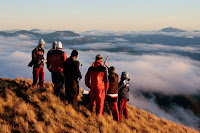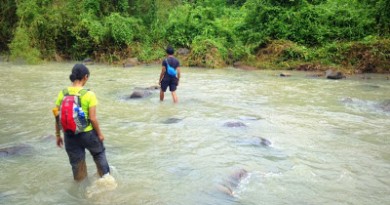Altitude sickness in Philippine mountains
 This is an article belonging to the ‘climb health‘ category in PinoyMountaineer. Information provided in this article are based on research and are not meant as a substitute to actual medical advice and healthcare.
This is an article belonging to the ‘climb health‘ category in PinoyMountaineer. Information provided in this article are based on research and are not meant as a substitute to actual medical advice and healthcare.
BACKGROUND
Philippine mountains are not classified as ‘very high altitude’, in fact Mt. Apo is just a little more than a third of the height of Mt. Everest. However, altitude sickness, medically known as acute mountain sickness (AMS) still be a concern. Every person responds differently to varying air conditions, and some are more sensitive with changes in the quality of air.
 How does gaining altitude affect the human body? The explanation delves first into physics then shifts into human physiology. First, we know that as you go higher, air gets thinner. The level of oxygen decreases as well. When the body gets less oxygen (hypoxia), a lot of things happen.
How does gaining altitude affect the human body? The explanation delves first into physics then shifts into human physiology. First, we know that as you go higher, air gets thinner. The level of oxygen decreases as well. When the body gets less oxygen (hypoxia), a lot of things happen.
The human body has the ability to acclimatize, but it takes time. So actually the problem with altitude sickness is not the change in altitude per se, but the rapidity of the change.
Specifically, it has been observed that AMS begins at around 2400 MASL. There are at least thirty mountains in the Philippines that are above this elevation, including the popular ones such as Mt. Pulag and Mt. Apo, so this is a real concern for hikers. Furthermore, with the recent thrust to explore mountains abroad, such as Mt. Kinabalu (4095 MASL), there should be awareness regarding this matter. Finally, since altitude is a high concern among asthmatics, a few paragraphs are devoted to this concern below.
SYMPTOMS
What are the symptoms of AMS? Before we enumerate them, I have to emphasize that altitude sickness manifests in a spectrum of symptoms, and most people would only have very mild, almost imperceptible symptoms. This is why a lot of people climb Mt. Pulag without feeling anything. At the mild level of AMS, the following symptoms are experienced: transient headache, sleeping difficulty, and some shortness of breath.
Moderate symptoms include difficulty of breathing, cough, weakness, insomnia, and ‘pins and needles’ sensation. There could likewise be edema or swelling of the hands, feet, and face.
Severe, life-threatening symptoms would include persistent dry cough, vomiting, persistent headache, and fever. Changes in consciousness and altered behavior may ensue. These severe symptoms may fall under two dangerous emergencies, High Altitude Pulmonary Edema (HAPE) or High Altitude Cerebral Edema (HACE).
PREVENTION
Acclimatization. If you are sensitive to high altitudes, and feel uncomfortable due to the symptoms mentioned above, then you may want to acclimatize first. Adjustments that the body do to overcome the decrease in oxygen is to increase the number of red blood cells in the bloodstream. Mountaineers in other countries have a dictum, “Climb high, sleep low”, describing the regimen done to acclimatize. High-altitude climbers ascend from basecamp, then return, gradually prolonging the interval and increasing the altitude gain, with around 300-400m net gain per day beyond 3000 MASL. In the Philippines where all mountains are below 3000m, there is no hard and fast rule, but in the case for instance of Mt. Pulag, you may want to stay in Baguio first, then proceed to the basecamp in Ambangeg, before proceeding to the summit the next day. Regularly climbing mountains, at least once a month, may be contributory to acclimatization.
Pharmacologic measures. Taking Acetazolamide (Diamox) tablets has been demonstrated to prevent Acute Mountain Sickness. The recommended dosage for prevention is 125-250mg twice a day, starting a day before the ascent until the end of the climb. There are other drugs that can be taken such as Dexamethasone, a steroid, and Nifedipine, which is commonly used to treat hypertension. But I recommend seeking a doctor’s advice on whether these are appropriate for your use.
Oxygen supplementation. Available in other countries where canned oxygen or oxygen-concentrating devices can be bought, this is currently not an option in the Philippines. In Japan, a popular preparation for Mt. Fuji are sanso cans containing anywhere between 3-20 L of oxygen. The human body requires 250ml oxygen/minute.
TREATMENT
If you develop moderate to severe symptoms of AMS, go to a lower altitude as soon as possible. Climbers must have the sufficient courage to overcome summit obsession, among other things, and descend immediately. Of course, if the symptoms are only mild then you can proceed with the climb with caution – being vigilant with the symptoms and applying
Medics on a climbing party can dispense Acetazolamide (Diamox) 250mg/tablet, thrice a day for treatment of mild to moderate AMS. Medical attention must be sought immediately for severe AMS, together with the prompt evacuation of the sufferer to a lower elevation.
ASTHMA AND ALTITUDE
Asthma is a medical condition that diminishes lung function, and theoretically, there is risk of worsening asthma, with the decreased oxygen in air. However, asthmatics generally tolerate high altitude well, and as long as your asthma medications are updated, complete, and optimal, then you can go mountain climbing. In fact, several research papers have reported beneficial effects of high altitude among asthmatics! They reported reduction of asthma attacks and lesser need for medications among asthmatics who frequently climbed mountains. Interestingly enough, the locals of Mt. Banahaw de Lucban say that some asthmatics who climbed their mountain have been cured of their illness!
The only time you should reconsider climbing is if your asthma is uncontrolled, meaning you’ve had asthma attacks more than 3x/week and you are using your inhalers more often. Otherwise, only a dose of caution is prescribed (and dont forget your controller medications / inhalers). If you are unsure about your asthma status, seek medical advice and get clearance before you proceed with your climb.
CONCLUSION
Altitude sickness, or AMS, is an important health concern among mountain climbers, even in the Philippines. Although more commonly presenting with mild, transient symptoms such as headache and sleep disturbances, it may cause life-threatening conditions among some. Identifying symptoms of severe AMS, as well as the modes of treatment and prevention, is recommended for all hikers, especially among medics of climbing teams. However, for most hikers AMS does not seem to pose a significant risk and should not be a reason for not climbing the highest mountains in the Philippines.
REFERENCES
Harrison’s Principles of Internal Medicine, 16th Edition.
Kale et. al, Altitude-related Disorders. eMedicine:med/3225
Schultze-Werninghaus G. Effects of high altitude on bronchial asthma. Pneumologie. 2008 Mar;62(3):170-6.
The author is currently a fourth year medical student at the University of the Philippines – Philippine General Hospital under the INTARMED program.






Leave a Reply
7 Comments on "Altitude sickness in Philippine mountains"
Hmm is anуonе еlsе
encounteгing problems ωіth the ρiсtures on this blog loadіng?
I'm trying to find out if its a problem on my end or if it's thе blog.
Аny ѕuggestionѕ would
be greаtly appreciаteԁ.
Also visit my page ; play yard swing sets
we had first-hand experience of AMS! but not in the Philippines, during our trek to the Himalayas in Nepal. we're currently updating our blog and it includes this topic. check out http://roamingronos.com/2010/04/all-roads-lead-to-tengboche/ for initial posts 🙂
what’s happening to the cells when AMS occurs?why theres edema and dry cough?
oxycan costs 238-250php/can..
it’s availble at olympic store outlets,
bombproof, toby’s and a lot more..
cool, how much does a can cost?